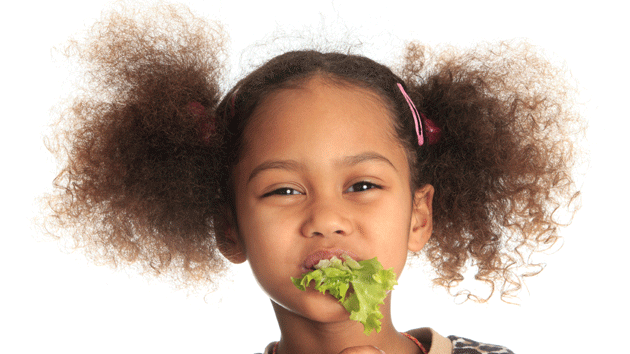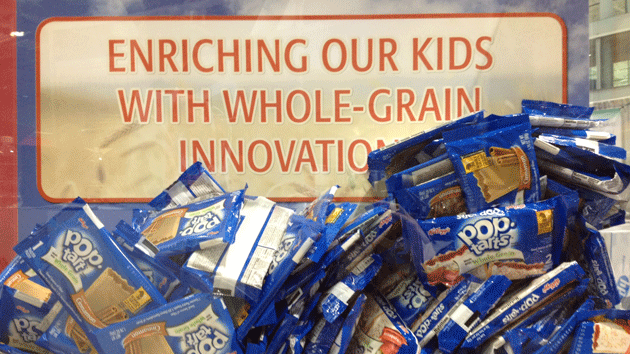
<a href="http://www.shutterstock.com/pic-96176183/stock-photo-beautiful-asian-child-african-american-black-child-eats-salad-isolated-metisse.html?src=csl_recent_image-1" target="_blank">Michael Borges</a>/Shutterstock
Striding past samples of Pop Tarts and pizza and cookies, Jessica Shelly made a beeline for a booth selling individually packaged sliced fruits and veggies. She picked up a pouch of sliced peaches and let out a yelp of delight. “This could be really fabulous,” she said. “I’m thinking yogurt. I’m thinking granola. I’m thinking make-your-own breakfast parfait!” She waved the peaches around in the air triumphantly. People began to give us odd looks.
Before meeting Shelly, I hadn’t known it was possible to muster quite this much enthusiasm for sliced peaches. Then again, someone with any less energy probably wouldn’t be able to do Shelly’s job: As the director of food services for Cincinnati’s public schools, she is wholly responsible for providing nutritious breakfast, lunch, and snacks to 34,000 public school students, three-quarters of whom are on free or reduced-price meals.
Here in the exhibition hall at the annual conference of the School Nutrition Association (SNA), the group that represents the nation’s 55,000 school food professionals, Shelly wasn’t the only one with a tough job—all 6,500 attendees had their work cut out for them. They had to find food that would appeal to kids, otherwise it would go right from a child’s tray to the garbage can. The food must be easy to prepare; some school kitchens are too small to do anything more than heat up a prepared meal. It also has to be very, very cheap. Most of the nutrition directors told me that once they pay overhead costs, they are left with only a dollar or two per student.
This month, their job got harder still. A new set of federal nutritional standards—including a requirement that students must take a fruit or vegetable with lunch and a rule that half of foods served must be composed of at least 51 percent whole grains—went into effect on July 1. Even stricter rules are coming: In 2017, the sodium limit will be further reduced. * (Read Mother Jones‘ Alex Park’s guide to the food companies that lobbied on the new rules here.)
The School Nutrition Association supports some of the changes that have already been implemented—the current whole grain rule, for instance, and the stipulation that only skim milk can be flavored. But it opposes others, such as the fruit or vegetable requirement, and the increase to 100 percent whole-grain rich foods.
Patti Montague, the School Nutrition Association’s CEO, blamed the rules for a 1.2 million-student decline, since 2011, in daily cafeteria attendance. “It got to the point where we felt like we needed to do something,” she told me. “We’re looking to get some flexibility for our members.”
Some of the school food directors I talked to echoed Montague’s concerns. Yvette Burrows, from Picayune Memorial High School in Mississippi, worries that her students will turn their noses up at unfamiliar foods. “It’s not that we don’t try to get them to try it,” she said. But most of them end up not liking the healthy stuff they’re required to taste.” Earlier this year, when her kitchen switched its biscuit dough from white to whole grain, students were not pleased. “One white biscuit is not going to make them unhealthy,” she said.
But Shelly has found that with a little creativity, it’s possible to tempt kids to the lunchroom. Ohio tightened its nutrition standards several years ago, so Shelly has had some time to develop tricks. One winning strategy, she says, is to encourage kids to personalize their meals. She worked with her produce distributor to create affordable salad bars, where kids can load up on the veggies they like. She also installed spice stations—think ranch, lemon pepper, and hot chili—so that kids could decide how to season their food. One day a week, she invites teachers into the lunchrooms to model healthy eating. On these mentoring days, teachers eat free.
Another part of the job, she says, is marketing. She regularly asks students to score foods served in the cafeteria. When she changed the name of a sandwich from “chicken patty on a whole grain bun” to “oven baked chicken sandwich,” the students scored the sandwich three points higher on average. She also made lunchrooms more inviting, ditching the long tables for booths she picked up for cheap at restaurants that were going out of business. During a conference session she led, she underscored the importance of letting parents know that healthy food was available at school. “They don’t know,” she said. “They think we’re feeding them carnival food. They think I’m making mystery meat in the back kitchen with road kill.”
Her tactics seem to be working. While the rest of the nation’s lunchrooms have seen historic declines in attendance over the last few years, cafeterias in Shelly’s program have actually grown more popular—and turned a $2.7 million profit.
Similarly, Steve Marinelli, a school food director from a rural Vermont district where 43 percent of the students are on free or reduced lunch, told me his schools “had no problems whatsoever implementing the new changes.” He attributed the success to partnerships with nutrition-education nonprofits that offer taste tests of healthy foods in classrooms to help get students used to unfamiliar flavors. Marinelli believes that it takes time to change a child’s diet, and that schools shouldn’t be forced to implement the new changes too quickly. But “I think SNA has to fix their PR. They are so negative about these standards.”
Indeed, when I suggested to SNA’s Montague that maybe the students just needed more time to get used to the new foods—and maybe the cafeterias needed a few years to figure out how to make the healthier options appealing—she shook her head. “They don’t have enough money to wait for kids to get used to these new regulations,” she said. “Where is that money going to come from when the kids aren’t going to the lunchroom anymore?” And “even if you got all the money it wouldn’t solve all the problems,” she said. “Kids want what they have at home.”
The conference’s exhibition hall certainly reflected Montague’s belief. As I reported earlier this week, it was filled with new food formulations that follow the letter of the law, but offer little by way of nutrition: 51 percent whole grain funnel cakes and Rice Krispies Treats, for example.

I asked SNA spokeswoman Diane Pratt-Heavner whether the group had considered limiting junk food. “Exhibit floors in general reflect a vast array of company sizes and offerings,” she responded via email. “Exhibitors were required to only offer items that meet USDA regulations for Child Nutrition programs.”
Shelly isn’t giving up, though. The first time her cafeterias served chicken nuggets breaded with whole-wheat flour, the kids thought something must have gone terribly wrong in the kitchen. “They went back into the lunch line and said, ‘you burnt these,'” Shelly said. “Practically all the nuggets ended up in the garbage.” Undaunted, she scoured her suppliers for an alternative and finally she found a nugget with a lighter-colored breading. It also happened to contain whole-muscle meat instead of processed chicken parts.
“Some people think making kids eat healthy food is an impossible task,” she says. “I think it’s an opportunity.”
Correction: The original version of this post stated that a new rule would raise the whole-grain requirement from 51 percent to 100 percent of a given food. The rule actually applies to all grain foods: The old rule required that half of grain foods served must be whole-grain rich (which is defined as 51 percent whole grain). Starting July 1, all grain foods served must be whole-grain rich. The post has been corrected.

















